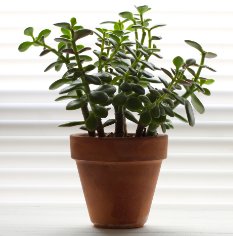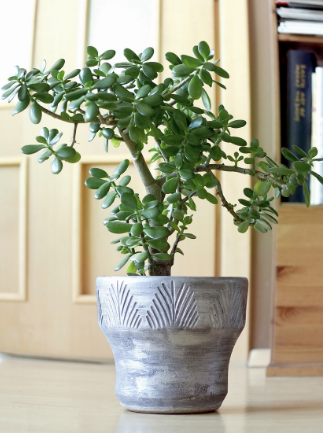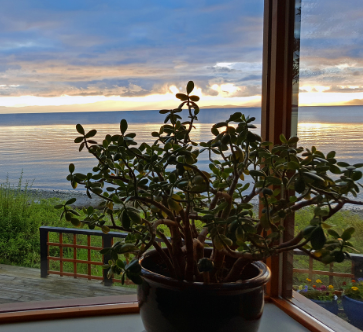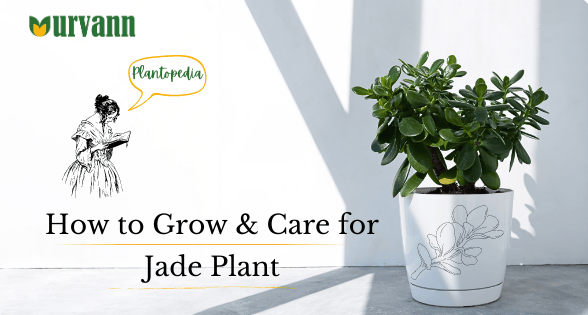Jade plant has long been a favorite of houseplant enthusiasts for its plump fleshy leaves, miniature tree-like form, and unchallenging nature. Also known as the lucky plant, the jade plant signifies luck, wealth, prosperity, and friendship in many Asian cultures. It thus makes for an excellent housewarming or congratulatory present. They are some of the easiest houseplants to grow, and who doesn’t love easy? Here's how to easily grow and care for Jade plants in your home!
WATER, SUNLIGHT, AND SOIL CARE NEEDS OF JADE PLANT

WATERING- How often should you water your Jade plant? The most common mistake people make when it comes to succulent care is overwatering. Consistent overwatering is their number one killer!
- Jade Plants are succulents, so they store water in their leaves. Water the plant only when the top 2 inches soil is dry as it is important not to overwater them.
- Make sure you let the water drain away fully – do not let the plant sit in water as this may cause the roots to rot.
- Reduce watering in fall and winter when plants enter a period of semi-dormancy.
SUNLIGHT- Jade Plant appreciates at least 4 hours of direct sunlight to thrive happily. Young plants might need more indirect sunlight, it should be kept indoors near windows and in rooms with good air ventilation. However, if you are looking for bushy and healthy Jade plants, keep them outdoors in full sun. Jade plants can survive indoors, but they thrive outdoors!
BEST SOIL- Jade Plant prefers loose well-draining and aerated soil and does best in a cactus or succulent mix. If you choose to use an all-purpose potting mix used for generic house plants, add some perlite, wood chips to help assist with drainage.
BEST SEASON TO GROW JADE PLANT IN INDIA- Such plants can be grown in any season anytime.
PROPAGATION OF JADE PLANTS

How to Propagate Jade Plants via Stem Cuttings
Step 1: Cut a thick stem (three to five inches long) with healthy leaves with clean, sharp gardening scissors. Remove the bottom leaves, then place the cutting in a sunny position for a few days until the cut end creates a lighter-colored callus that feels firm.
Step 2: Make a long, thin hole in the center of a tiny pot filled with succulent soil. Apply rooting hormone (powdered or liquid) to the lowest inch of the callused stem to assist roots in developing faster. Place the stem in the pot gently, then pat the soil down until the cutting stands up on its own.
Step 3: For three to four weeks, keep the cutting out of direct sunshine. When fresh growth appears, gradually move it closer to a brightly lit window. During this period, only use a small amount of water.
How to Propagate Jade Plants via Leaf Cuttings
Step 1: Remove a large, healthy-looking leaf with a clean, sharp blade.
Step 2: Place the leaf in dry succulent soil and keep it out of direct sunlight until roots appear. A mix of equal parts succulent soil and perlite or vermiculite can soften the soil texture to encourage development, and rooting hormone can be put to the cut end of the leaf.
Step 3: After many weeks, look for little roots sprouting from the cut end of the leaf. Place the leaf in a tiny container filled with a fast-draining soil combination like perlite-sand. As the roots take hold, new growth will emerge, and the original leaf will shrivel completely.
COMMON PROBLEMS WITH JADE PLANTS AND CARE
Jade plants are relatively easy to care for, but there are a few common problems you may encounter :
- Dropping leaves, dark or soft stems or leaves, and mushy brown roots: The most common reason for this is moisture stress which can be from overwatering. Make sure you let the water drain away fully – do not let the plant sit in water as this may cause the roots to rot.
- Wrinkled Leaves: Because jade plants store water in their leaves, wrinkly or shrivelled leaves are a good indication that your plant isn't getting enough water. They may be accompanied by drooping or a general "wilt" of the whole plant but should perk up quickly once watered.
- Mealy Bugs: Jade Plants are prone to attack by mealy bugs. To avoid, mix a small amount of Neem cake fertilizer in the soil mix. Also, spray your plant thoroughly with neem oil solution every 15 days (Mix neem oil in water and add 2 drops of liquid soap). All parts of the plant- leaves, branches should be thoroughly sprayed.

BENEFITS OF JADE PLANT
It is believed that Jade Plants have medicinal and non-medicinal benefits.
- It enhances air quality by assisting in the removal of volatile organic compounds particularly toluene and acetone. Keeping a Jade Plant on the bedside table helps to clear the air at night.
- As an evergreen plant, it is a symbol of good fortune and stability.
- It requires very little upkeep.
- Tea prepared from the leaves of the Jade Plant is used to cure wounds, stomach distress, warts, and diabetes in Chinese culture and by several African tribes and groups.
- Its attractiveness increases the appearance of any space.
Keeping your Jade Plant healthy and happy is easy when you provide what it needs – adequate water, right temperatures, and proper sunlight!


